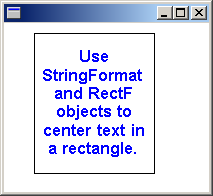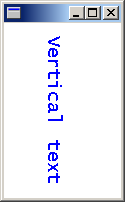テキストの書式設定 (GDI+)
テキストに特別な書式を適用するには、StringFormat オブジェクトを初期化し、そのオブジェクトのアドレスを Graphics クラスの DrawString メソッドに渡します。
四角形に書式設定されたテキストを描画するには、 Graphics、 FontFamily、 Font、 RectF、 StringFormat、 Brush オブジェクトが必要です。
テキストの配置
次の例では、四角形にテキストを描画します。 テキストの各行は中央揃え (左右)、テキストブロック全体が四角形の中央 (上から下) に配置されます。
WCHAR string[] =
L"Use StringFormat and RectF objects to center text in a rectangle.";
FontFamily fontFamily(L"Arial");
Font font(&fontFamily, 12, FontStyleBold, UnitPoint);
RectF rectF(30.0f, 10.0f, 120.0f, 140.0f);
StringFormat stringFormat;
SolidBrush solidBrush(Color(255, 0, 0, 255));
// Center-justify each line of text.
stringFormat.SetAlignment(StringAlignmentCenter);
// Center the block of text (top to bottom) in the rectangle.
stringFormat.SetLineAlignment(StringAlignmentCenter);
graphics.DrawString(string, -1, &font, rectF, &stringFormat, &solidBrush);
Pen pen(Color(255, 0, 0, 0));
graphics.DrawRectangle(&pen, rectF);
次の図は、四角形と中央揃えのテキストを示しています。

上記のコードは 、StringFormat オブジェクトの StringFormat::SetAlignment と StringFormat::SetLineAlignment の 2 つのメソッド を呼び出します。 StringFormat::SetAlignment の呼び出しは、テキストの各行が、DrawString メソッドに渡される 3 番目の引数によって指定された四角形の中央に配置されることを指定します。 StringFormat::SetLineAlignment の呼び出しは、テキストブロックが四角形の中央 (上から下) であることを指定します。
値 StringAlignmentCenter は、Gdiplusenums.h で宣言されている StringAlignment 列挙の要素です。
タブ位置の設定
文字列のタブ位置を設定するには、StringFormat オブジェクトの StringFormat::SetTabStops メソッドを呼び出し、その StringFormat オブジェクトのアドレスを Graphics クラスの DrawString メソッドに渡します。
次の例では、タブ ストップを 150、250、350 に設定します。 次に、コードに名前とテスト スコアのタブ付きリストが表示されます。
WCHAR string[150] =
L"Name\tTest 1\tTest 2\tTest 3\n";
StringCchCatW(string, 150, L"Joe\t95\t88\t91\n");
StringCchCatW(string, 150, L"Mary\t98\t84\t90\n");
StringCchCatW(string, 150, L"Sam\t42\t76\t98\n");
StringCchCatW(string, 150, L"Jane\t65\t73\t92\n");
FontFamily fontFamily(L"Courier New");
Font font(&fontFamily, 12, FontStyleRegular, UnitPoint);
RectF rectF(10.0f, 10.0f, 450.0f, 100.0f);
StringFormat stringFormat;
SolidBrush solidBrush(Color(255, 0, 0, 255));
REAL tabs[] = {150.0f, 100.0f, 100.0f};
stringFormat.SetTabStops(0.0f, 3, tabs);
graphics.DrawString(string, -1, &font, rectF, &stringFormat, &solidBrush);
Pen pen(Color(255, 0, 0, 0));
graphics.DrawRectangle(&pen, rectF);
次の図は、タブ付きのテキストを示しています。

上記のコードは、 StringFormat::SetTabStops メソッドに 3 つの引数を渡します。 3 番目の引数は、タブ オフセットを含む配列のアドレスです。 2 番目の引数は、その配列に 3 つのオフセットがあることを示します。 StringFormat::SetTabStops に渡される最初の引数は 0 です。これは、配列内の最初のオフセットが、外接する四角形の左端である位置 0 から測定されることを示します。
縦書きテキストの描画
StringFormat オブジェクトを使用すると、テキストを水平方向ではなく垂直方向に描画するように指定できます。
次の例では、StringFormat オブジェクトの StringFormat::SetFormatFlags メソッドに値 StringFormatFlagsDirectionVerticalを渡します。 その StringFormat オブジェクトのアドレスは、Graphics クラスの DrawString メソッドに渡されます。 値 StringFormatFlagsDirectionVertical は、Gdiplusenums.h で宣言されている StringFormatFlags 列挙の要素です。
WCHAR string[] = L"Vertical text";
FontFamily fontFamily(L"Lucida Console");
Font font(&fontFamily, 14, FontStyleRegular, UnitPoint);
PointF pointF(40.0f, 10.0f);
StringFormat stringFormat;
SolidBrush solidBrush(Color(255, 0, 0, 255));
stringFormat.SetFormatFlags(StringFormatFlagsDirectionVertical);
graphics.DrawString(string, -1, &font, pointF, &stringFormat, &solidBrush);
次の図は、縦書きのテキストを示しています。
